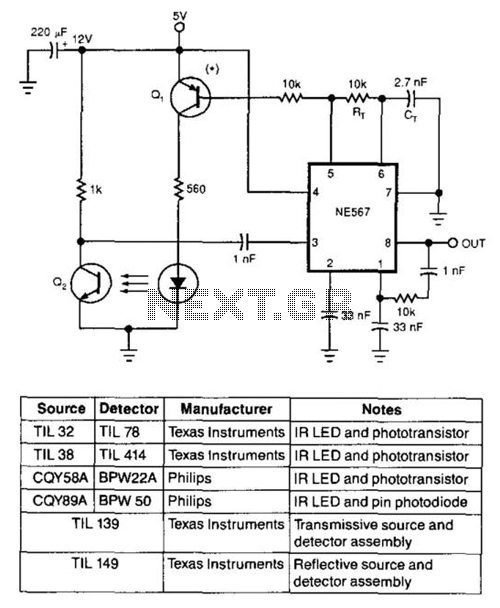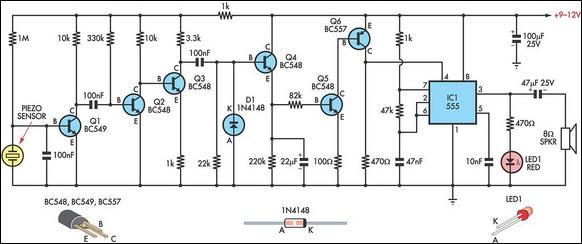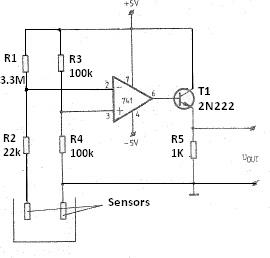
Optical Interruption Sensor

Using only an 8-pin integrated circuit (IC) and a few discrete components, an infrared optical interrupter can be constructed. The NE567 tone decoder includes all necessary circuit elements: a local oscillator, a phase-locked loop (PLL) decoder, and a 100-mA output drive capability. The local oscillator, tuned to 40 kHz by resistors RT and capacitor CT, drives Q1, a universal low-power silicon PNP transistor (such as a 2N3906, BC559, or ZTX500). Q1, in turn, drives the infrared emitting diode (LED). The receiving section of the circuit is connected to pin 3 of the IC, which serves as the internal PLL input. When the photodetector, Q2, detects the oscillating infrared light beam, a 40 kHz signal is present at pin 3 of the IC, causing the circuit to lock and the output of the IC to be high. If an opaque object interrupts the path between the LED and Q2, the 40 kHz signal is blocked from reaching the PLL input, resulting in a low output from the IC. A feedback network between pins 1 and 8 prevents output chatter. When connected to a high-inertia load, such as a mechanical relay, the output remains stable, allowing for the elimination of feedback components. This circuit is compatible with virtually any LED-photodetector pair, although matched pairs can facilitate longer distances between the emitter and receiver.
The infrared optical interrupter circuit utilizes the NE567 tone decoder IC, which integrates a local oscillator and PLL decoder, making it efficient and compact. The local oscillator's frequency is set to 40 kHz through the careful selection of resistor RT and capacitor CT, which define the timing characteristics of the oscillator. The output from this oscillator is fed into Q1, a low-power PNP transistor, which acts as a switch to control the infrared LED.
The infrared LED emits modulated light, which is then detected by Q2, the photodetector. When the LED's light is unobstructed, Q2 detects the modulated infrared signal, generating a corresponding output signal at pin 3 of the NE567. This output signal indicates that the path between the emitter and receiver is clear, resulting in a high output from the IC. Conversely, when an opaque object obstructs the light path, the signal is interrupted, leading to a low output state.
The feedback network between pins 1 and 8 is crucial for maintaining output stability and preventing oscillations, which can occur due to noise or rapid changes in the detected signal. This feature is particularly important when interfacing with inductive loads, such as relays, where mechanical inertia can introduce delays and fluctuations in the output.
The versatility of this circuit allows it to work with various LED and photodetector combinations, although using matched pairs can enhance performance by optimizing the range and sensitivity of the interrupter. The circuit can be suitable for applications such as object detection, counting systems, or safety barriers, where the interruption of a light beam must be reliably detected. Using only an 8-pin IC and a few discrete components, you can build the infrared optical interrupter. The NE567 tone decoder has all the necessary circuit elements: a local oscillator, a PLL decoder, and a 100-mA output-drive capability. The local oscillator, which is tuned to 40 kHz by RT and CT, drives Ql, a universal low-power silicon pnp transistor (such as a 2N3906, BC559, or ZTX500).
Ql drives the IR-emit-ting diode. The receiving part of the circuit surrounds the ICs internal PLL input at pin 3. When the pho-todetector, Q2, detects the oscillating IR light beam, the 40-kHz signal appears at pin 3 of the IC, Under this condition, the circuit locks and the ICs output is high. When something opaque comes between the LED and Q2, the 40-kHz signal doesn"t reach the PLL input, and the ICs output goes low.
The feedback network between pins 1 and 8 prevents the output from chattering. If you connect this circuit to a high-inertia load (such as a mechanical relay), the output doesn"t tend to oscillate and you can eliminate these feedback components. The circuit works with virtually any LED-photodetector pair, but matched pairs allow for longer distances between the emitter and receiver.
The table lists some of the best choices.
The infrared optical interrupter circuit utilizes the NE567 tone decoder IC, which integrates a local oscillator and PLL decoder, making it efficient and compact. The local oscillator's frequency is set to 40 kHz through the careful selection of resistor RT and capacitor CT, which define the timing characteristics of the oscillator. The output from this oscillator is fed into Q1, a low-power PNP transistor, which acts as a switch to control the infrared LED.
The infrared LED emits modulated light, which is then detected by Q2, the photodetector. When the LED's light is unobstructed, Q2 detects the modulated infrared signal, generating a corresponding output signal at pin 3 of the NE567. This output signal indicates that the path between the emitter and receiver is clear, resulting in a high output from the IC. Conversely, when an opaque object obstructs the light path, the signal is interrupted, leading to a low output state.
The feedback network between pins 1 and 8 is crucial for maintaining output stability and preventing oscillations, which can occur due to noise or rapid changes in the detected signal. This feature is particularly important when interfacing with inductive loads, such as relays, where mechanical inertia can introduce delays and fluctuations in the output.
The versatility of this circuit allows it to work with various LED and photodetector combinations, although using matched pairs can enhance performance by optimizing the range and sensitivity of the interrupter. The circuit can be suitable for applications such as object detection, counting systems, or safety barriers, where the interruption of a light beam must be reliably detected. Using only an 8-pin IC and a few discrete components, you can build the infrared optical interrupter. The NE567 tone decoder has all the necessary circuit elements: a local oscillator, a PLL decoder, and a 100-mA output-drive capability. The local oscillator, which is tuned to 40 kHz by RT and CT, drives Ql, a universal low-power silicon pnp transistor (such as a 2N3906, BC559, or ZTX500).
Ql drives the IR-emit-ting diode. The receiving part of the circuit surrounds the ICs internal PLL input at pin 3. When the pho-todetector, Q2, detects the oscillating IR light beam, the 40-kHz signal appears at pin 3 of the IC, Under this condition, the circuit locks and the ICs output is high. When something opaque comes between the LED and Q2, the 40-kHz signal doesn"t reach the PLL input, and the ICs output goes low.
The feedback network between pins 1 and 8 prevents the output from chattering. If you connect this circuit to a high-inertia load (such as a mechanical relay), the output doesn"t tend to oscillate and you can eliminate these feedback components. The circuit works with virtually any LED-photodetector pair, but matched pairs allow for longer distances between the emitter and receiver.
The table lists some of the best choices.





